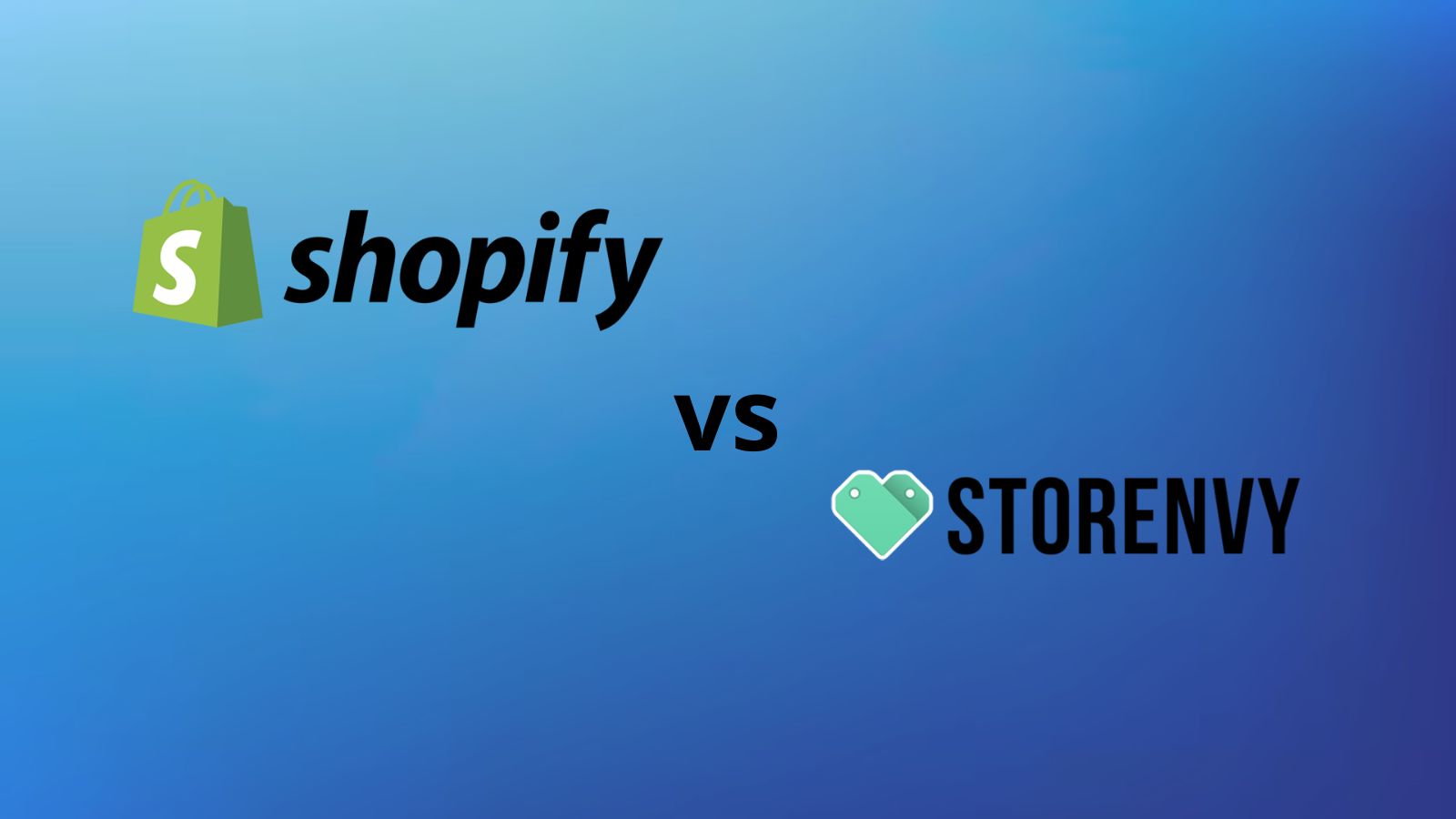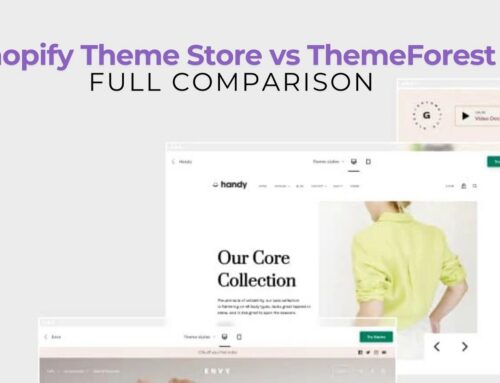There is no doubt that eCommerce has been a massively booming industry for decades. Nowadays, everyone wants to do business online. So if you are looking to start your own store, choosing the right eCommerce platform is always a critical decision. And in case you’re struggling to choose between Storenvy vs Shopify, this article is for you.
With our ultimate comparison of Shopify vs Storenvy, you will definitely have all the information you need to make a decision. Let the comparison begin. Don’t worry. We will lead the way.
About Shopify vs Storenvy
First thing first, you need to make sure you know some basics about each platform.
What is Shopify?

Shopify is a powerful platform with everything you need to create your online store and sell anything.
Currently, it is one of the most popular hosted eCommerce platforms on the market.
With Shopify, you can easily build and manage a professional online store with your chosen domain URL.
What is Storenvy?

Storenvy is a platform for small brands and authentic goods. They describe themselves as a “social marketplace”. Their interface looks like a social media platform.
On Storenvy, buyers can like or add items to their collections and message sellers directly.
Pros and cons of Shopify vs Storenvy
I assure you that both platforms are excellent. But each has some advantages and disadvantages as well.
To know exactly which is the right platform for you, you need to know their good and bad.
Compare the pros and cons of Shopify vs Storenvy in the table below.
| Pros | Cons | |
|---|---|---|
| Shopify | – Easy to set up and manage – Provides beautifully-designed templates – Include extensive features |
– Need to know Liquid template language to make backend changes – Cost extra fees if you’re using third-party payment gateways (instead of Shopify payments) – The lowest-priced doesn’t show you your store’s reports |
| Storenvy | – Access to a large social marketplace. – A fully independent store. – Very cost-effective |
– Need to pay high fees to show your items on the marketplace. – Limited functionality compared to Shopify – The marketplace isn’t as large as Etsy and eBay |
Shopify vs Storenvy – Comparison Table
The table below is a summarized version of Storenvy vs Shopify comparison for you to take a quick look.
| Shopify | Storenvy | |
|---|---|---|
| Platform type | Webstores | Marketplaces |
| Design | Provides 10 free templates and over 60 premium templates | Provides 20 themes and only 2 free themes |
| Code requirements | No coding knowledge required but you have to work in Liquid template language to customize | No coding knowledge required at all |
| Feature | Mainly centered around web store development and management and exceptional ease of use | Only some basic commerce features |
| Domain URL | Let you choose your unique domain | Provide to you a unique domain |
| Shipping | Advanced shipping abilities | Basic shipping tools |
| Analytic | Provide a powerful analytic tool with detailed statistics | Integrated Google Analytics |
| Free plan | 14-day trial to test with a published store | Has forever-free plan |
| Pricing | Starting at $29 per month | Starting at $15 per month |
| Additional fees | Transaction fees | Commission fees |
You may concern about Key differences between Shopify vs Ebay
#5 Key differences between Shopify vs Storenvy
And below, we will show you the 5 key differences between Shopify vs Storenvy in detail.
Shopify vs Storenvy: Ease of Use

Ease of use is one of the most important factors to consider when you choose a platform, why? Because you wouldn’t want to spend days setting up your store only to realize it is impossible for you to manage, would you? So how simple is it to run an online store on Storenvy vs Shopify platform?
To Shopify, ease of use is one area where it shines more than most other platforms. You don’t need to be a web designer or coder to build your store. All orders can be managed from their automatable fulfillment dashboard. It will save a lot of time and effort for you. And whether you use the desktop or mobile devices, responsiveness is both taken care of.
Storenvy brings you the same experience. It is one of the easiest-to-use eCommerce platforms. With no design and technical knowledge needed, you will definitely find it appealing. They also provide a central dashboard so you can access various areas for managing your store, including orders, marketplace listings, marketing, storefront design, and so on.
However, the initial set-up can be a little complicated and takes more time compared to Shopify.
🎯 Shopify vs Storenvy: Ease of Use
✨ Shopify wins! Start your business on Shopify now!
Shopify vs Storenvy: Pricing and Additional fees

When starting a business, pricing becomes a critical consideration. Let’s compare Shopify and Storenvy to determine which offers better value for money.
Shopify offers four main plans:
- Shopify Lite: $9/month
- Basic Shopify: $19/month
- Shopify: $49/month
- Advanced Shopify: $299/month
For a comprehensive list of features per plan, please visit the Shopify website. They also provide a 14-day free trial for testing before committing to a plan.
Additionally, Shopify offers Shopify Plus, an upgraded version for large enterprises. Pricing starts at $2300/month and varies based on customizations and sales volume.
Keep in mind that Shopify charges an extra fee if you use a payment gateway other than their own solution, Shopify Payments. The additional fee ranges from 0.2% to 2% per payment, depending on your plan.
🎁🎁🎁 More details about Shopify pricing plan
On the other hand, Storenvy stands out by providing a forever-free plan along with three other options:
- Hobbyist: Free, with up to 20 products.
- Artisan: $7.99/month, up to 100 products, offering additional features like discounts.
- Growth: $19.99/month, up to 500 products, including automation tools.
- Professional: $39.99/month, up to 5000 products with all Growth plan features plus.
For a detailed feature list for each plan, visit the Storenvy website. Storenvy uses Stripe and PayPal as their payment providers, with associated fees.
The significant advantage of Storenvy is that they do not charge additional fees for products sold through your store. However, if your product is sold via a listing on their marketplace, they will apply a 15% charge on the final sale price, including shipping fees.
In conclusion, Shopify provides an array of excellent features and support, but it comes with varying monthly costs and additional payment gateway fees. On the other hand, Storenvy offers a free plan and does not charge extra for products sold through your store, making it a budget-friendly option.
🎯 Shopify vs Storenvy: Pricing and Additional fees
✨ Storenvy wins!
Storenvy vs Shopify: Design flexibility

As we all know, first impressions are vital. It is always a challenge to impress your customers at their first glance when they visit your online store. No matter which platform you choose, it is crucial to understand that there are already thousands of stores before you, making the competition fierce. The store design plays a pivotal role in helping your store stand out compared to others. In this article, we will delve into a comprehensive comparison between Shopify and Storenvy, focusing on their designing tools and capabilities.
Shopify: Unleash the Power of Well-Designed Templates
Shopify, a popular e-commerce platform, offers a plethora of well-designed templates to choose from. Currently, it boasts an impressive collection of 10 free and over 60 premium templates, providing you with the freedom to create an attractive-looking store. However, there’s a catch – their premium templates come with a hefty price tag of $180 each, and the free templates may appear somewhat basic.
One of the significant advantages of Shopify is its user-friendly interface, which makes it suitable for individuals with no coding background. You can easily make changes to colors, images, and other visual elements without getting tangled in complex coding jargon.
Nevertheless, if you desire more extensive backend modifications, you might need to collaborate with a developer. Shopify’s templates are written in Liquid templating code, which can be quite challenging to access if you lack programming knowledge.
Storenvy: Unleash Your Creativity with HTML and CSS Editing
On the other hand, Storenvy provides a website builder coupled with an HTML and CSS editor, catering to users with some coding experience. This gives them the flexibility to make any customizations they desire, providing them with an edge over non-technical users.
Similar to Shopify, Storenvy’s non-technical users also have limited control over their storefront. Changes can be made to colors, text, banners, images, and other layout components, ensuring a level of personalization while maintaining ease of use.
Additionally, Storenvy boasts an extensive range of themes to choose from. While some themes come with an extra charge of around $30 each, they offer unique and attractive options for those willing to invest in their store’s appearance.
Shopify vs Storenvy: Which One Is the Winner?
Now that we have weighed the design capabilities of both Shopify and Storenvy, the question remains – which one is better? The answer lies in your specific needs and expertise.
If you prioritize user-friendliness and pre-designed templates, Shopify is the go-to option for you. It simplifies the process for non-coders to set up an appealing store, and its vast collection of templates ensures you will find a suitable one for your niche.
Conversely, if you possess coding knowledge and crave complete control over your store’s design, Storenvy is the way to go. Its HTML and CSS editor empowers you to bring your creative vision to life without relying on developers.
Ultimately, both platforms offer their unique advantages, and your decision should be based on your comfort level with coding, budget constraints, and design preferences. Remember, your store’s first impression can make or break your online business, so choose wisely to create an unforgettable shopping experience for your customers.
🎯 Shopify vs Storenvy: Design flexibility
✨ It is a tie!
Shopify vs Storenvy: Analytics

Analytics uses data and mathematics to address business inquiries, playing a crucial role in enhancing your business. Consequently, analytic tools form an essential feature of any eCommerce platform.
Shopify, for instance, offers an overview dashboard that provides valuable business insights through analytics. Within this dashboard, users can access statistics such as sales figures, top-performing products, landing page performance, referrers, returning customer rates, and more.
Furthermore, Shopify empowers its users to effortlessly create custom reports tailored to their specific needs. Additionally, the Advanced Shopify and Shopify Plus plans include pre-defined reports, enhancing the analytics capabilities further.
On the other hand, Storenvy lacks its own built-in analytic tools, which is a limitation. However, they do permit users to integrate third-party analytics tools, like Google Analytics, to gain some level of insights. Other than that, you can also see some insights like:
- Sales counts from your Storenvy Store and on Storenvy Marketplace
- Unique visitors and page view counts
- Top referring URLs
- Top search engine terms
It’s worth noting that while Storenvy’s integrated analytics may provide some basic insights, it may not match the comprehensive and robust features offered by Shopify’s integrated analytics.
🎯 Shopify vs Storenvy: Analytics
✨ Shopify wins!
Keep reading Wix vs Shopify: Which One is Better in Pricing, Features & Functionalities?
Help and Support

Whether you are new to online business or an experienced entrepreneur, encountering issues is inevitable. Having reliable support in times of trouble is crucial to getting back on track. Let’s compare the help and support centers of Shopify and Storenvy.
Shopify offers an exceptional support system available 24/7 via email, phone, and live chat for all their plans. Customers praise the quality of support in their reviews. Moreover, the email support is provided in multiple languages, not just English. With a vast community of thousands of online shop owners, Shopify boasts the most active users’ community. You can easily find help by joining a Facebook group or forum dedicated to Shopify.
On the other hand, Storenvy’s customer service can be a bit disappointing. They only offer technical support through email or a contact form, lacking phone or live-chat assistance. Receiving a response may take up to twenty-four hours. There is no premium support available on any higher plan either. Based on customer reviews, the speed of help seems to depend on luck when dealing with Storenvy’s support team. Additionally, their user communities are not as active as Shopify’s.
In summary, if you encounter a problem with Storenvy, your best option might be to remain patient and calm while waiting for their support service to respond. However, if you prefer quicker and more comprehensive support, Shopify appears to be the better choice due to its various support channels and active user communities.
🎯 Shopify vs Storenvy: Help and Support
✨ Shopify wins!
Conclusion

Remember that your online store has different requirements and business models compared to any other store. So it means you have to decide for yourself which platform you should use. But to make it easier for you, we will once again point out the most significant difference between Storenvy vs Shopify sums up:
Shopify is a shop management system that is very powerful in terms of customization and support, and has more of a commercial feel, suitable for small to large businesses.
Storenvy is a craft marketplace, it costs much less, but you will need to put more effort into making your item display widely, suitable for selling niche or self-making products.
If you are still unsure which one to choose, we recommend you try their free plans to test them out by yourself.
I hope this article is helpful for you to choose between Shopify vs Storenvy. And If you are interested in discovering more about Shopify services, themes, and apps, please visit BSS Commerce.





